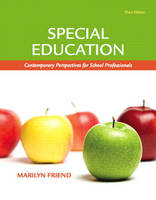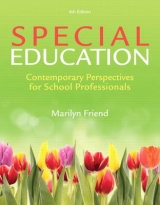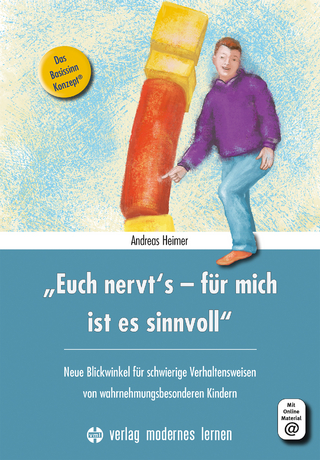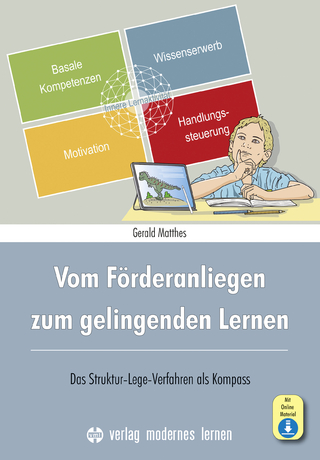
Special Education
Pearson (Verlag)
978-0-13-703327-0 (ISBN)
- Titel erscheint in neuer Auflage
- Artikel merken
Real Teachers, Real Families and Students, Real Classrooms, Real Research.
Emphasizing contemporary concepts and evidence-based practices that prepare teachers for their evolving roles in the education and well-being of students with disabilities, Marilyn Friend combines current research with practical information for educators working in this challenging age of high standards and accountability. With an emphasis on curriculum access, inclusive practices, professional collaboration, and student diversity, the third edition integrates the requirements of NCLB and IDEA legislation with evidence-based practices so that readers understand the expectations for educators and students, and learn how critical concepts translate into educational practices.
Marilyn Friend has been a professional educator for more than thirty years. She has worked as a general education teacher and a special education teacher, as well as a teacher educator, researcher, and staff developer. Her specific areas of expertise include collaboration among school professionals, inclusive practices, coteaching, and differentiated instruction. What makes Dr. Friend somewhat unique is the balance in her professionals activities: Although she is a university faculty member, she maintains close contact with elementary, middle, and high school professionals; and she helps educators in rural, suburban, and urban school districts to refine their practices for meeting diverse student needs. Currently, she is a professor of special education in the Department of Specialized Education services at the Unviersity of North Carolina at Greensboro.
Preface.
Special Features.
1. Key Concepts for Understanding Special Education.
Learning Objectives.
Key Terms and Concepts
What Is Special Education?
What Are the Laws for Students with Disabilities?
Who Receives Special Education?
What Are the Recommended Practices That Characterize Today's Special Education?
What Are the Perspectives of Parents and Families on Special Education?
What Trends and Issues Currently Influence Special Education?
Summary.
2. The Personnel and Procedures of Special Education.
Learning Objectives.
Key Terms and Concepts
Who Are the Professionals Who Work in Special Education?
How Do Students Become Eligible to Receive Special Education Services?
What Is an Individualized Education Program?
What Are the Services Students with Disabilities Receive?
What Are the Options for Resolving Disagreements Regarding Special Education?
What Are the Issues Related to Special Professionals and Procedures?
Summary.
3. Multicultural and Bilingual Perspectives.
Learning Objectives.
Key Terms and Concepts
What Is Culture?
How Does Culture Affect the Learning Process?
How Are Culturally Diverse Groups Represented in Special and Gifted Education?
What Are Best Educational Practices for Diverse Learners with Exceptionalites?
What Are the Perspectives of Parents of Diverse Exceptional Learners?
What Are the Trends and Issues Affecting the Education of Diverse Exceptional Learners?
Summary.
4. Creating Partnerships through Collaboration.
Learning Objectives.
Key Terms and Concepts
What Is Collaboration?
What Elements Are Necessary for Collaboration?
How Is Collaboration Implemented in Schools?
How Does Collaboration Involve Parents and Families?
What Are Issues Related to Collaboration?
Summary.
5. Students with Learning Disabilities.
Learning Objectives.
Key Terms and Concepts
What Are Learning Disabilities?
What Are the Characteristics of Individuals with Learning Disabilities?
How Are Learning Disabilities Identified?
How Do Learners with Learning Disabilities Receive Their Education?
What Are Best Educational Practices for Students with Learning Disabilities?
What Are the Perspectives of Parents and Families?
What Trends and Issues Are Affecting the Field of Learning Disabilities?
Summary.
6. Students with Attention Deficit-Hyperactivity Disorder.
Learning Objectives.
Key Terms and Concepts
What Is Attention Deficit Hyperactivity Disorder?
What Are the Characteristics of Individuals with Attention Deficit Hyperactivity Disorder?
How Is Attention Deficit Hyperactivity Disorder Identified?
How Do Learners with Attention Deficit Hyperactivity Disorder Receive Their Education?
What Are Best Educational Practices for Students with Attention Deficit Hyperactivity Disorder?
What Are the Perspectives of Parents and Families?
What Trends and Issues Are Affecting the Field of ADHD?
Summary.
7. Students with Emotional and Behavior Disorders.
Learning Objectives.
Key Terms and Concepts
What Are Emotional and Behavior Disorders?
What Are the Characteristics of Individuals with Emotional and Behavior Disorders?
How Are Emotional and Behavior Disorders Identified?
How Do Learners with Emotional and Behavior Disorders Receive Their Education?
What Are Best Educational Practices for Students with Emotional and Behavior Disorders?
What Are the Perspectives of Parents and Families?
What Trends and Issues Are Affecting the Field of Emotional and Behavior Disorders?
Summary.
8. Students with Intellectual and Developmental Disabilities.
Learning Objectives.
Key Terms and Concepts
What Is Mental Retardation?
What Are the Characteristics of Individuals with Mental Retardation?
How Is Mental Retardation Identified?
How Do Learners with Mental Retardation Receive Their Education?
What Are Best Educational Practices for Students with Mental Retardation?
What Are the Perspectives of Parents and Families?
What Trends and Issues Are Affecting the Field of Mental Retardation?
Summary.
9. Students with Speech and Language Disorders.
Learning Objectives.
Key Terms and Concepts
What Are Speech and Language Disorders?
What Are the Characteristics of Individuals with Speech and Language Disorders?
How Are Speech and Language Disorders Identified?
How Do Learners with Speech and Language Disorders Receive Their Education?
What Are Best Educational Practices for Students with Speech and Language Disorders?
What Are the Perspectives of Parents and Families?
What Trends and Issues Are Affecting the Field of Speech and Language Disorders?
Summary.
10. Students with Autism Spectrum Disorder.
Learning Objectives.
Key Terms and Concepts
What Are Autism Spectrum Disorders?
What Are the Characteristics of Individuals with Autism Spectrum Disorders?
How Are Autism Spectrum Disorders Identified?
How Do Learners with Autism Spectrum Disorders Receive Their Education?
What Are Best Educational Practices for Students with Autism Spectrum Disorders?
What Are the Perspectives of Parents and Families?
What Trends and Issues Are Affecting the Field of Autism Spectrum Disorders?
Summary.
11. Students with Severe and Multiple Disabilities.
Learning Objectives.
Key Terms and Concepts
What Are Severe and Multiple Disabilities?
What Are the Characteristics of Individuals with Severe and Multiple Disabilities?
How Are Severe and Multiple Disabilities Identified and Assessed?
How Do Learners with Severe and Multiple Disabilities Receive Their Education?
What Are Best Educational Practices for Students with Severe and Multiple Disabilities?
What Are the Perspectives of Parents and Families?
What Trends and Issues Are Affecting the Field of Severe and Multiple Disabilities?
Summary.
12. Students with Physical and Health Disabilities.
Learning Objectives.
Key Terms and Concepts
What Are Physical and Health Disabilities?
What Are the Characteristics of Individuals with Physical and Health Disabilities?
How Are Physical and Health Disabilities Identified?
How Do Learners with Physical and Health Disabilities Receive Their Education?
What Are Best Educational Practices for Students with Physical and Health Disabilities?
What Are the Perspectives of Parents and Families?
What Trends and Issues Are Affecting the Field of Physical and Health Disabilities?
Summary.
13. Students with Deafness and Hearing Loss.
Learning Objectives.
Key Terms and Concepts
What Are Deafness and Hearing Loss?
What Are the Characteristics of Individuals Who Are Deaf or Hard of Hearing?
How Is a Hearing Loss Identified?
How Do Learners Who Are Deaf or Hard of Hearing Receive Their Education?
What Are Best Educational Practices for Students Who Are Deaf or Hard of Hearing?
What Are the Perspectives of Parents and Families?
What Trends and Issues Are Affecting the Field of Deaf Education?
Summary.
14. Students with Visual Impairments.
Learning Objectives.
Key Terms and Concepts
What Is Visual Impairment?
What Are the Characteristics of Individuals with Visual Impairments?
How Is Visual Impairment Identified?
How Do Learners with Visual Impairment Receive Their Education?
What Are Best Educational Practices for Learners with Visual Impairments?
What Are the Perspectives of Parents and Families?
What Trends and Issues Are Affecting the Field of Visual Impairment?
Summary.
15. Students Who Are Gifted and Talented.
Learning Objectives.
Key Terms and Concepts
What Is Giftedness?
What Are the Characteristics of Individuals Who Are Gifted and Talented?
How Are Learners Who Are Gifted and Talented Identified?
How Do Learners Who Are Gifted and Talented Receive Their Education?
What Are Best Educational Practices for Students Who Are Gifted and Talented?
What Are the Perspectives of Parents and Families?
What Trends and Issues Are Affecting the Field of Gifted Education?
Summary.
References.
Glossary.
Index.
| Erscheint lt. Verlag | 19.5.2010 |
|---|---|
| Sprache | englisch |
| Maße | 284 x 223 mm |
| Gewicht | 1456 g |
| Themenwelt | Sozialwissenschaften ► Pädagogik ► Sonder-, Heil- und Förderpädagogik |
| ISBN-10 | 0-13-703327-3 / 0137033273 |
| ISBN-13 | 978-0-13-703327-0 / 9780137033270 |
| Zustand | Neuware |
| Haben Sie eine Frage zum Produkt? |
aus dem Bereich



